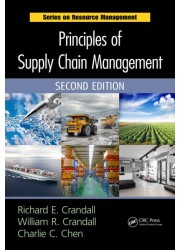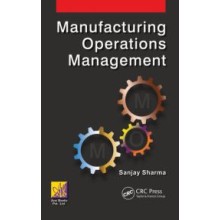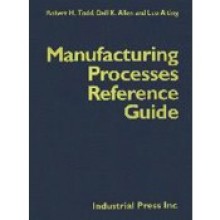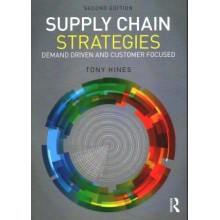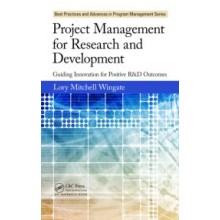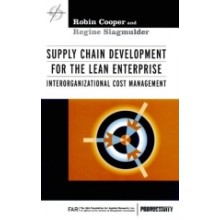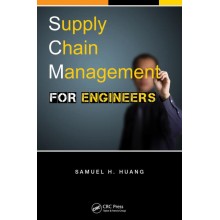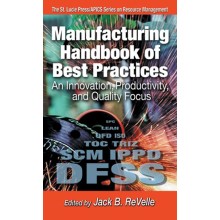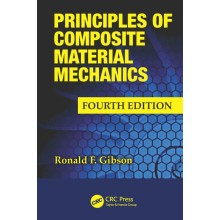Principles of Supply Chain Management, Second Edition
ISBN: 9781482212020
Author: Richard E. Crandall, William R. Crandall, Charlie C. Chen
Dispatch Time: 2 - 3 Days
Quantity:
-
Add to Compare
The second edition of this popular textbook presents a balanced overview of the principles of supply chain management. Going beyond the usual supply chain text,Principles of Supply Chain Management not only details the individual components of the supply chain, but also illustrates how the pieces must come together. To show the logic behind why supply chain management is essential, the text examines how supply chains are evolving, looks ahead to new developments, and provides a balanced look at supply chains with a focus on both the customer side and the supplier side of supply chains.
Table of Contents
Preface to the Second Edition
Preface to the First Edition
Acknowledgments
Introduction
Authors
Chapter Outline
OVERVIEW OF SUPPLY CHAIN MANAGEMENT
Evolution of Supply Chains
Learning Outcomes
Company Profile: Procter & Gamble (P&G)
What Is a Supply Chain?
Importance of SCM
Evolution of Supply Chains
Early Supply Chains
Local Supply Chains
Global Supply Chains
Changing Government Orientation
State-Controlled Governments
Market-Driven Governments
Current Trends that Link Supply Chain Participants More Closely
Relationship Building
Electronic Business
Developing Economies
Outsourcing
Need for Quality Improvement
Changing Customer Demands
Current Developments in SCM
Power Has Shifted from Manufacturers to Retailers
Consolidation of Small, Local, or Regional Retailers into National Chains
Emergence of "Killer Category" Retailers
From a Make-and-Sell Mentality to a Sense-and-Respond Orientation
Obstacles to Supply Chain Integration
Need for Globalization
Complexity of Arranging Entities with Common Interests
Lack of Effective Interorganizational Systems
Need for Multiple Supply Chains within Companies
Lack of Trust between Participants
Examples of Companies with Successful Supply Chains
Summary
Hot Topic: Outsourcing to Low Wage Countries
Discussion Questions
References
Supply Chains as a System
Learning Outcomes
Company Profile: Zara’s
Introduction
Supply Chain Systems
Inputs
Transformation
Outputs
Manufacturing versus Services
Characteristics of Supply Chains
Physical Flow
Information Flow
Funds Flow
Relational Flow
Examples of Supply Chains in Different Industries
Internal and External Customers
Open Systems versus Closed Systems
Effect of External Influences on Supply Chains
Obstacles and Enablers of Supply Chain Integration
Obstacles
Enablers
Performance Measurement
Allocation of Costs, Resources, and Benefits along the Supply Chain
Value Creation as the Ultimate Objective
Summary
Hot Topic: How a Natural Disaster Can Cripple a Supply Chain
Discussion Questions
References
DEMAND PERSPECTIVE
Determining Customer Needs
Learning Outcomes
Company Profile: McDonald’s
Introduction
Group Customers into Homogeneous Segments
Determine Needs of the Ultimate Consumer
Product Needs
Service Needs
Marketing Mix
Manufacturing and Service Supply Chains
Accurately Determine Customer Needs
Approaches
Market Research
Open System Scanning
Develop Reliable Demand Forecasts
Quantitative Forecasting Methods
Qualitative Forecasting Methods
Collaborative Forecasting
Determine the Attributes of a Well-Designed Product
Functionality (Product Works to Satisfy Customers’ Needs)
Validity (Product Has Value and Functions at a Reasonable Cost)
Manufacturability (Product Can Be Efficiently Produced)
Reliability (Product Has a Variety of Quality Attributes)
Serviceability (Product Can Be Serviced during Its Effective Life)
Recyclability (Product Can Be Recycled along the Reverse Logistics Supply Chain)
Consider Alternative Product Design Approaches
Quality Function Deployment
Concurrent Engineering
Design for Manufacturability
Design for Sustainability
Determine the Number of Supply Chains Needed by a Company
Align with Customer Segment
Align with Product/Service Bundle
Align with Supplier Category
Align with Common Incentives
Respond to Needs of Internal Customers
Conclusion
Hot Topic: Human Trafficking
Discussion Questions
References
A System to Meet Customer Needs
Learning Outcomes
Company Profile: GE Aviation
Supply Chain Models
Global Supply Chain Forum Model
Customer Relationship Management
Origins of CRM
What Can CRM Do?
Benefits
CRM Processes
Problems
CRM’s Future
Product Life Cycle Management
What Is PLM?
How Did PLM Evolve?
What Does PLM Include?
What Does PLM Not Include?
What Are the Benefits of PLM?
What Are the Obstacles?
What Is the Present Status of PLM?
What Does the Future Hold?
Supply Chain Configuration
Basic (Generic) Supply Chain
Variations for Different Industries
Supply Chain Mapping
Determining Resource Requirements
Facilities
Equipment
Employees
Inventory
Information Systems
Designing Processes to Match with Products
Make to Stock
Assemble to Order
Make to Order
Engineer to Order
Determining the Mix of Make and Buy
Core Competency Concept
Total Cost of Ownership
Cost Reduction versus Revenue Increase Considerations
Effect of Outsourcing Movement
Aligning Entities along the Supply Chain
Entities to Be Involved
Allocation of Authority and Responsibility among Entities
Collaboration Process
Implementation Plan
Evaluating the System Design
Will It Accomplish Its Objectives?
Is It Sustainable?
Is It Flexible?
Summary
Hot Topic: Sweatshops
Discussion Questions
References
Demand Management
Learning Outcomes
Company Profile: NextEra
Introduction
Definition of Demand Management
Importance of Demand Management
Managing Demand
Accept All Demand
Select the Types of Demand to Accept
Solicit External Input in Forming Demand Patterns
Design the Form in Which Demand Will Be Accepted
Impose Constraints on Demand Submission
Managing Supply
Select a Demand Management Strategy
Develop a Demand-Forecasting System
Determine the Resource Requirements to Meet the Demand
Merging Supply and Demand into a Demand Management Process
Sales and Operations Planning to Match Short-Term Supply and Demand
Collaboration among Supply Chain Participants
Demand Management in Manufacturing
Demand Management in Services
Proposed Demand Management Strategies
Factors That Affect Selection of a Demand Management Strategy
Resources’ Value
Type of Demand
Top Management Strategies
Relationship between Factors and Strategies
Model for Integrating Demand and Supply Management
Programs Used to Implement Demand Management Strategies
Provide Strategy Programs
Match Strategy Programs
Influence Strategy Programs
Control Strategy Programs
Demand Management along the Supply Chain
Retail
Wholesale
Manufacturer
Mining and Agriculture
Summary
Hot Topic: The Problem of Cheap
Discussion Questions
References
SUPPLY PERSPECTIVE—DISTRIBUTION, PRODUCTION, PROCUREMENT, AND LOGISTICS
Distribution and Retailing
Learning Outcomes
Company Profile: Lowe’s
Introduction
Retail Function
History of Retailing
Characteristics of the Industry
Customers and Markets
Outputs
Inputs
Transformation Process
Impact on Operations Management
Designing the Retail Process
Strategic Orientation
Critical Design Points: Keys to Success
Additional Factors to Consider in Retail Store Design
Managing a Retail Business
Determine the Expected Demand
Plan Capacity to Meet Demand
Implement the Operating Plan
Measure Performance
Replan for the Next Period
Retail and Inventory Management
Value
Availability
Variety
Presentation
Service
Response Time
Present Situation in Retailing
Future in Retailing
Role of Wholesalers and Distribution Centers
Ordering
Receiving
Stocking
Picking
Loading the Trucks
Transporting to Stores
Unloading and Display at Stores
Critical Success Factors for Distribution
Inventory within Distribution Functions
Inventory Management between Retailer and Distributor
Technology in Distribution Functions
At the Retail Store
Movement of Goods
At the Distribution Center
Distribution Center Design
Positioning Services within the Distribution Functions
Presale Services
Postsale Services
Role of Third-Party Service Providers
Distribution Performance Measurement
Financial Performance Measures
Operating Performance Measures
Collaboration Performance Measures
Retailer–Distributor Relationship
Summary
Hot Topic: Contaminated Milk
Discussion Questions
References
Production and Service Processes
Learning Outcomes
Company Profile: Caterpillar
Introduction
Evolution of the Production Function
From Craft to Mass Production
From Mass Production to Mass Customization
Critical Success Factors for Manufacturers
Cost and Efficiency
Quality
Responsiveness: Timing of Delivery
Responsiveness: Product/Service Mix
Flexibility
Agility
Information Technology
Manufacturing Strategies
Make to Stock
Locate to Order
Assemble to Order
Make to Order
Engineer to Order
Batch to Lean Operations
Present Batch Flow
Proposed Lean Production Flow
Customer Lead Time
Extra Available Space
Faster Detection of Quality Problems
Ease of Transferring Operators
Reduced Scheduling Requirements
Smaller Lot Sizes
No Buildup of WIP Inventory
Empowered Employees
Reduced Equipment Breakdowns
Reduced Late Material Deliveries
Obstacles to Implementing Lean
Make or Buy Strategies
Vertical Integration
Outsourcing
Capacity Planning
How Much Capacity? When? What Kind?
Location and Ownership
Service Production Strategies
Relationships with Downstream Customers
From Transactions to Processes
Transactions versus Processes
Basic Processes of a Business
Benefits of a Process Orientation
Effect of Process Orientation
Organizational Structure
Strategies
Knowledge Management
Change Management
Trends in Production
From Manual to Automated
From Domestic to Global
From Standard Products to Customized
Postponement
Sales and Operations Planning
Additive Manufacturing
Performance Measurement
As Measured by Accounting
As Measured by Production
Measures along the Supply Chain
Summary
Hot Topic: Clothing Manufacturing
Discussion Questions
References
Procurement/Purchasing
Learning Outcomes
Company Profile: Nestlé
Introduction
Role of Procurement in the Supply Chain
Traditional Purchasing
Contemporary Purchasing
Changing Role of Purchasing
Critical Success Factors for Purchasing
Functionality
Availability
Cost
Quality
Match Inflow with Outflow
Reduce Variances in Delivery
Increase Supplier Dependability
Reduce the Bullwhip Effect
Become an Intercompany Facilitator
Find Sustainable Suppliers
Purchasing Functions: Participating
Product Design
Product Specifications
New Product Introduction
Target Costing
Strategic Sourcing
Supplier Location
Inventory Management
Supplier Risk Management
Purchasing Functions: Directing
Purchasing Process
Supplier Evaluation
Supplier Relationship Management
Supply Chain Coordination/Collaboration
Purchasing along the Supply Chain
Consumer
Retail
Wholesale
Manufacturer
Mining and Agriculture
Services
Offshore Outsourcing
As a Strategic Concept
TCO Considerations
As a Project, with Project Management Needs
Other Considerations: Intangible Costs and Public Acceptance
Supplier Location as a Strategy for Entering an Offshore Market
Performance Measurement
Traditional: Positive Purchase Price Variance
Contemporary: Enhanced Value for the Consumer
Future of Purchasing
Summary
Hot Topic: Why Apple Juice Should Be Made from … Apples
Discussion Questions
References
Logistics: The Glue That Holds the Supply Chain Together
Learning Outcomes
Company Profile: Transportation Insight
Scope of Logistics
Evolution of Integrated Logistics
Transportation
Truck: Privately Owned or Third-Party Carriers
Rail: For Selected Goods
Waterways
Air
Pipeline
Parcel
Transmission Lines
Fiber-Optic Cable Networks
Materials Management
Interim Storage
Exchange Points
Traceability
Integration
Outsourcing
Drivers of the Outsourcing Movement
Steps in the Outsourcing Decision
Reshoring Initiative
Rise of 3PLs
Benefits of 3PL Services
Obstacles to Successful Implementation
Trend toward Outsourcing the Distribution Function
Major Companies
Role of 4PL in Building Supply Chain Relationships
High-Tech Industry Issues
Risk Management
Status Report
Hot Topic: Container Shipping and its Risk Points
Discussion Questions
References
Reverse Supply Chains
Learning Outcomes
Company Profile: GENCO
Introduction
Description of Reverse Supply Chain Networks
Benefits of Reverse Logistics
Barriers to Reverse Logistics
Continuation of Forward Supply Chains
History of Reverse Logistics
Principal Drivers of the Movement
Individual Consumers
Individual Businesses
Society as a Group
Business Sector
Educational Institutions
Governments: At All Levels
Activities in Reverse Logistics
Service: Assure Proper Use of Product
Returns: Repackaging or Relocation
Restoration: Minor Modification or Repair
Remanufacturing: Overhaul and Major Rebuilding
Recycling: Reconstitution as Part of Another Product
Disposal: Return to Natural State
Hazardous Waste Disposal
Role of Private Industry
New Paradigms in Product Design (Design for Sustainability)
Design and Operate Green Supply Chains
Develop Systems to Manage Reverse Logistics
Participate in Joint Ventures to Seek Social Objectives
Role of Government
Research: To Identify Threats and Opportunities
Legislation: To Standardize Business Requirements
Regulation: To Monitor Performance
Participation: To Encourage and Support Ongoing Programs
Role of Consumer
Participant in Reverse Supply Chain Programs
Educated Consumer
Supporter of Green Supply Chain Efforts
Reverse Logistics Network
Continuation of the Forward Supply Chain
Open System Environment
Heavily Outsourced by Major Businesses
Need for a Life Cycle Systems Approach
Need for IT
Other Considerations in Designing Reverse Supply Chains
Future
Growth in Amount of Materials Recycled
Increase in Number of Companies Performing Reverse Logistics Activities
Joint Ventures between Private Business and Government
Increased Emphasis on Prevention, Not Just Reusing
More Companies Will Design Integrated Reverse Logistics Systems
Summary
Hot Topic: Reshoring: Revisiting the Make or Buy Decision
Discussion Questions
References
NEED FOR INTEGRATION
The Need to Integrate
Expected Outcomes
Company Profile: Cisco
Introduction
Setting the Stage
Reasons to Integrate
Research in Support of Integration Efforts
From Mass Production to Mass Customization
From Craft to Mass Production
Prelude to Mass Customization
From Vertical Integration to Virtual Integration
From Homogeneous Cultures to Diverse Cultures
From Bottom Line to Triple Bottom Line
Drivers of Change
Global Competition
Global Markets
Economic Advantage
Relationships and Trust among Supply Chain Participants
Trust between Individuals
Formal Contracts or Agreements
Common Interests or Projects (Enforced Trust)
Involves Change Management
Change Is Difficult within a Company
Change Is More Difficult for a Community
Change Is Most Difficult for an Entire Country
Steps in the Integration Process
Build Interfaces with Customers and Suppliers
Change Interfaces to Interlaces to Make the Relationships Closer
Change Interlaces to Integrated Relationships
Need for Strategic Planning
Categories of Operations
Normal Operations
Improvement Programs
Problem-Solving Programs
Crisis Management
Need for a Multiyear Project Plan
Performance Measurement across the Supply Chain
Integration Requires Sharing
Summary
Hot Topic: Atomic Energy Canada Limited Encounters Problems with Its Cancer-Fighting Machine, Part 1
Discussion Questions
References
Why Integration Is Difficult
Learning Outcomes
Company Profile: Boeing
Introduction
Determining Strategic Objectives
Evaluating the Potential Return on Investment
Uncertainty of Benefits
Uncertainty of Costs
Uncertainty of Assets Employed
Designing for Participant Differences
Participants Are Not Equal
Technical Differences
Need for Multiple Supply Chains
Different Customer Segments
Different Supplier Segments
Different Logistics Networks
Separating Interwoven Networks
Selecting and Implementing Technology
Product and Service Processes
Incomplete Interorganizational Systems
Financial Funds Flow
Realigning Infrastructure
Internal Organization
Effect of Outsourcing Movement
External Organization
Policies and Procedures
Physical Infrastructure
Transforming Company Cultures
Internal
External
Building Relationships
Communicate
Coordinate
Cooperate
Collaborate
Lack of Trust Inhibits Collaboration
Measuring Performance
Maintaining the System
During the Implementation Process
During the Operation of the Supply Chain
Extension into Reverse Logistics
Obstacles to International SCM
Summary
Hot Topic: Atomic Energy Canada Limited Encounters Problems with Its Cancer Fighting Machine (Part 2)
Discussion Questions
References
How to Build an Integrated Supply Chain
Learning Outcomes
Company Profile: Interface, Inc.
Introduction
Who Manages the Supply Chain?
Past and Future of Supply Chain Management
Present Supply Chains
Virtual Supply Chains
Contractual Alliances
Dominant Party Management
Third-Party Direct Management
Third-Party Indirect (Third-Party) Management
World of Lean Production
Product
Purchasing Process
Production Process
Delivery Process
Demand Variation
Moving from Functional Focus to Cross-Enterprise Collaboration
Comprehensive Supply Chain Model
Decisions Needed to Achieve a Lean and Agile Supply Chain
Commitment
Concept
Configuration
Customization
Integrated Supply Chain
Coordination
Cooperation
Collaboration
Steps in the Change Process
Investigate
Involve
Include
Initiate
Invigorate
Implement
Integrate
Institutionalize
Innovate
A Look Ahead
Complexity
Clairvoyance
Summary
Hot Topic: Atomic Energy Canada Limited Encounters Problems with Its Cancer Fighting Machine (Part 3)
Discussion Questions
References
FINANCIAL AND INFORMATION TECHNOLOGY PERSPECTIVES
Information Flow along the Supply Chain
Learning Outcomes
Company Profile: SAP
Introduction
Need for Information Flow
Types of Information Transmitted
Upstream Suppliers
Midstream (Internal)
Downstream Customers
Reverse Supply Chain
Supply Chain Connectivity
Intracompany Technologies Used
Data Capture and Communication
Data Storage and Retrieval
Data Manipulation and Reporting
Supply Chain Direct Links
Customer Relationship Management
Supplier Relationship Management
Linking Technologies
Interorganizational Systems
EDI and Internet EDI
Linking Applications
Videoconferencing
Sales and Operations Planning
Product Life Cycle Management
Third-Party Services
Service-Oriented Architecture
Software as a Service
Cloud Computing
Benefits of Information Technologies
Tangible Benefits
Intangible Benefits
Barriers to IT Adoption
Technological Obstacles
Managerial Obstacles
Societal Obstacles
Model of an Integrated Supply Chain Information System
Summary
Hot Topic: The Boeing 787: A New Supply Chain Model in the Commercial Aircraft Industry—Part 1
Discussion Questions
References
Funds Flow along the Supply Chain
Learning Outcomes
Company Profile: Wells Fargo
Overview of the Flow of Funds
Need for Cash Flow within a Company
Supply Chain Funds Flow
Flows in a Supply Chain
Benefits of Improved Funds Flow
Obstacles
External Sources of Funds
Banks and Other Lending Institutions
Supply Chain Finance
Performance Measurement
Financial Accounting Measures: Current Ratio
Management Accounting Measures
Need for Finance and Operations to Collaborate
Effect of Production Strategies on Funds Flow
Effect of Outsourcing on Product Costs and Capital Requirements
Write a review
Your Name:Your Review: Note: HTML is not translated!
Rating: Bad Good
Enter the code in the box below:
Copyright © 2014 Engineering Standards Bureau. All Rights Reserved.
Developed By Zoom Into Web


